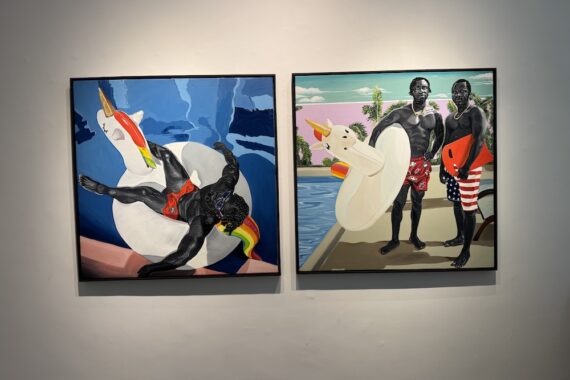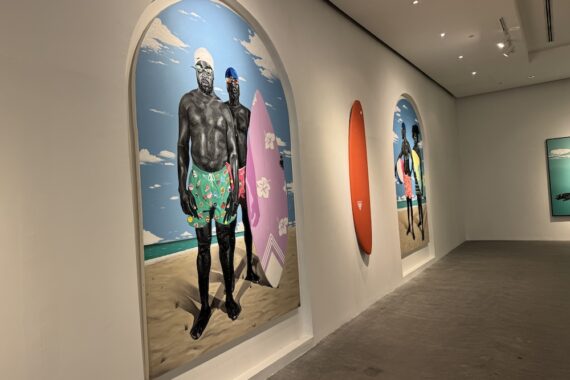By John Owoo
(Accra – Ghana)
Ghanaian-born, U.S.-based painter Otis Quaicoe makes a compelling return home with “Where the Waters Meet”, his first solo exhibition in Ghana at Gallery 1957. Indeed, the show marks a deeply personal moment in the artist’s career, reflecting on themes of belonging, freedom, and the radical necessity of rest.
His new body of work draws on his memories of Ghana and his experiences in the United States, bridging two worlds through the metaphor of water. Pools and oceans become spaces of ease and reclamation, where black bodies—long politicised in art and history—can exist in leisure. It’s a subtle yet powerful statement about self-possession and joy.
Rendered in a restrained palette of black and grey, Quaicoe’s portraits possess a quiet confidence. His tonal approach heightens the sculptural quality of his figures, who emerge with luminous presence against soft, dreamlike backgrounds. The technique allows him to shift focus from spectacle to emotion—from representation to reflection.
The artist recreates a vivid beach scene, spreading fine sand evenly across a large plastic sheet to evoke the shoreline. Scattered throughout the installation were traces of human presence—discarded plastic cups, worn children’s toys, and elegant beach chairs—arranged beneath a brightly multicoloured umbrella that conjured both leisure and environmental decay.
“In Intermission II,” a woman reclines beside a swimming pool, her book and drink suggesting a moment of calm. Yet her hand pauses mid-page, hinting at an undercurrent of unease. The stillness feels momentary, as if rest itself requires negotiation. Elsewhere, in “Diver”, a figure leaps toward water—an act of faith and release. Suspended between sky and sea, she embodies the exhibition’s central idea: that surrender can also be liberation.
Beyond its painterly grace, “Where the Waters Meet” resonates as a meditation on the diaspora experience. The title evokes the Atlantic Ocean, which connects Ghana to the broader Black world, suggesting a confluence rather than a separation. It also mirrors the artist’s own journey between his base in the US and Accra, as well as the broader desire for balance between mobility and a sense of home.
What stands out most is Quaicoe’s ability to translate personal emotion into collective experience. His paintings do not shout; they breathe. Through them, rest becomes both aesthetic and political—a way of reclaiming space and presence.
“Where the Waters Meet” is a mature, reflective exhibition from an artist attuned to both his origins and his evolution. It affirms Quaicoe as a painter who continues to expand the visual language of Black representation—this time, with quiet grace and depth.
The exhibition ends on Saturday, January 3, 2026.































